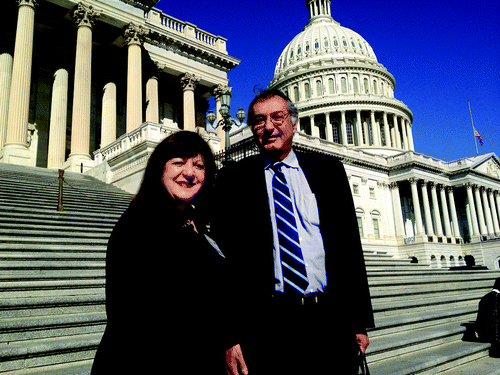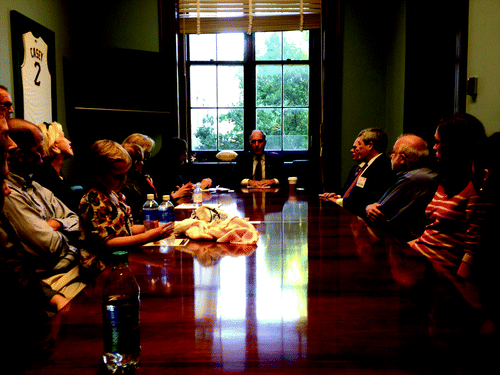On September 18, 2013, I participated in the Rally for Medical Research Hill Day where representatives of over 170 organizations, including my own institution, the Penn State Hershey Cancer Institute, came to speak with our legislators about the current crisis in biomedical research. Participants came from 40 states and included well over 200 cancer survivors, survivor and research advocates, scientists and clinicians as well as leaders of national organizations.
It was a beautiful sunny day with cool temperatures when I arrived at the capitol building and met with members of the Pennsylvania delegation who were getting ready to visit members of congress to bring the message.
Our delegation included Dr Margaret Foti, CEO of the American Association for Cancer Research (), Barbara Duffy Stewart, Executive Director for the Association of American Cancer Institutes, a patient with metastatic breast cancer, an 8-year-old child who benefited from cell therapy at the Children’s Hospital of Philadelphia, Yair Argon, a Professor and Division Head at the Children’s Hospital of Philadelphia, Mariell Jessup, President of the American Heart Association and Professor of Medicine at University of Pennsylvania, and several graduate and combined degree students from the University of Pennsylvania.
Figure 1. Dr Margaret Foti, Chief Executive Officer at the American Association for Cancer Research, and Wafik El-Deiry, Interim Director at the Penn State Hershey Cancer Institute, on the east side of the Capitol Building at the Rally for Medical Research Hill Day, September 18, 2013.

For some of our visits we were joined by Charles Sawyers (), President of the AACR, Carlos Arteaga, President Elect of the AACR, and George Weiner, Director of the Cancer Center at the University of Iowa.
Figure 2. Photo with Senator Bob Casey (center). To his immediate right are Margaret Foti, Mariell Jessup, and Barbara Duffy Stewart between two cancer survivors. To the Senator’s left are Charles Sawyers, Carlos Arteaga, Yair Argon, and students. Photo taken by Wafik El-Deiry.

I attended meetings in the offices of Representative Allyson Schwartz where we met with Madeleine Pannell, a Health Policy Fellow; Representative Joseph Pitts where we met with Monica Volante, Legislative Director; Senator Robert Casey where we met with the Senator as well as Sara Mabry, Legislative Assistant; Representative Charles Dent where we met with Drew Kent, Senior Policy Advisor/Counsel; Representative Mike Doyle where we met with Jean Roehrenbeck, Legislative Director; and Senator Pat Toomey where we met with Tessie Abraham, Counsel.
Our message in all of our meetings was simple: No more cuts to the NIH. We explained that the sequester, with a 5%, $1.6 billion cut to the NIH budget in 2013, threatens the funding of 700 research grants as well as cuts in clinical trials. Our patient with breast cancer made a very compelling case that her life is at stake if the next clinical trial that is cut is the one that may have a life-saving drug for her. We described international competition as well as progress made. For example Dr Sawyers described his involvement with the development of the drug Gleevec for chronic leukemia and how the field has progressed since then to offer more options for patients. The young patient who is currently free of disease benefited from a clinical trial of cell therapy at the Children’s Hospital of Philadelphia. Dr Weiner made the case that supporting research can reduce the costs of healthcare. For example, by determining that certain CT scans are unnecessary to follow patients treated for lymphoma, a $2 million grant can save $75 million each year. I spoke about how the budget has been flat for 10 years and how this has been stifling progress, including the moving of promising treatments from our labs to the clinic. The sequester has also introduced more instability for dedicated researchers whose positions have been threatened or eliminated. Our patients deserve better and we have to be careful because some of the impact will be felt 5–10 years from now.
While I have advocated for funding biomedical research for several years, on this day I was delighted to see participation by students who described their own journey and prospects for the future at leading institutions. Everybody agrees biomedical research is important and the students made the case that the answer should not be so complicated as to threaten a generation of scientists and the future availability of new treatments. The students made a case for how biomedical research supports the economy in other ways through companies that support the research enterprise or those that help develop emerging therapies.
While the message is simple and the need obvious, and the impact great on the population, the news on Capitol Hill was not particularly good on this day. It is clear we need to live within our means, and we need to cut spending in some areas so that other areas such as biomedical research can remain viable and not continue to wither away. Barbara Duffy Stewart made the case that when there were long lines at airports due to the sequester the problem was solved in a week. Surely we can do better for biomedical research. Part of the feedback we received is that our efforts are important and more of them are needed. We also learned that the votes must be there in congress to make research funding more of a national priority. We were told that we should work within our communities to raise awareness at a grass roots effort to get the message back to congress where it counts, through the vote of the people. We believe the general public would be outraged to learn what damage has been ongoing and is very likely to continue as a result of funding shortages. Great progress is being made but without the support for NIH, the ability to continue to unravel the mysteries of cancer and to bring new treatments to patients will continue to erode. The advice to scientists and clinicians is that the crisis in biomedical research needs to be part of our national dialog, at our dinner table, at town hall meetings, in our newspapers and magazines. We as a community need to be very active and much more than ever because as we were told, congress needs to hear this message every day.